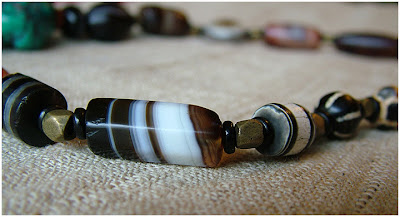Thursday, December 06, 2007
An old mala made up of coconut shell disc shaped beads and strung with carnelian spacers. Counters are attached to keep track of mantra accumulations. One side keeps track of the hundreds and the other keeps track of the thousands. When 10,000 mantras have been completed a marker (such as the small pieces of turquoise pictured) is moved one disc bead along. 10 disc beads would equal 100,000 recitations. For those who have several different types of mantras to recite then their mala may have several different markers.
Pictured above is a small metal Dorje (Vajra). This and similar pieces are usually strung on the tassle of a Guru bead. They can be fastened securely to a belt or an item of clothing. Tibetans still use these today to protect against loss and to stop their beads from falling on the floor. Very handy for Tibetans who are always on the move.
Tuesday, December 04, 2007
Friday, November 30, 2007
Ancient Pumtek beads from Burma. These beads are believed to date to the Pyu/Tircul period. The Pyu people were of Sino-Tibetan origin and were distinct from other Burmans. They establised the first state in Burma. Pumtek clearly have a lot in common with ancient dZi. It is possible that dZi beads influenced Burmese beads makers to create their own comparable beads. Pumtek are made from fossilised or petrified palmwood which is regarded as a variety of chalcedony. In Burma they are also known as 'Chin Pati' (Chin Beads) and are still highly prized as heirloom beads by the Chin people.
Sunday, November 25, 2007
Saturday, November 24, 2007
Tibetan woman, originally uploaded by susanhardman.
A Tibetan woman at the Tibetan horse festival in Qinghai. She is adorned with an outstanding collection of amber, coral and dZi. Such wealth is only worn during festivals and formal occasions.
Old Tibetan woman, Ladakh, originally uploaded by le petit danois.
The above image shows a Ladakhi woman. The chank shell (Turbinella pyrum) which is seen on her wrists is a precious material that is regarded as sacred throughout the Himalayan regions. It is widely known as conch but this is actually incorrect. A true conch is of the gastropod family known as Strombidae. Chank bracelets are usually placed on the wrists of young Ladakhi girls and once they have been outgrown they are cut off and replaced. A Ladakhi woman would wear these bracelets for the duration of her life.
Complete shells are used as ritual trumpets and are known by the name 'Dung Kar ' in Tibet. Shells that spiral to the right are particularly sought after and are regarded as the most sacred of these shells. It is also believed that the hair on the Buddhas crown spirals to the right. Round perforated disks (see image above) are an essential part of the hand held prayer wheel. A perforated disk sits at the top of the handle and helps the drum spin more smoothly. This is assisted by a length of bamboo that spins on the conch disk. Once the bamboo has managed to drill itself all the way through the disc, a new piece of conch is added and the process starts again. Used disks are usually worn as beads by the prayer wheel owner. These discs are collected over many years. Tibetans consider them to be imbued by energy of the thousands of mantras contained in the prayer wheel drum. Malas (prayer beads) can also be made from chank and are particularly sought after.
The chank shell plays an important role in Buddhist symbology. It is one of the Eight Auspicious symbols, which reflects the spreading of the Dharma in all directions, like the sound of a conch trumpet. It is regarded as a symbol which fearlessly proclaims the truth of the Buddha's teachings. It is also believed that a Buddha displays self-manifesting signs on his or her body. This is one of the many indications that shows they have achieved enlightenment. The chank shell appears on the Buddha's throat, the soles of the feet, palms, limbs, breast or forehead. It is also recognised that the Indian subcontinent is the shape of a chank shell.
Sunday, September 02, 2007
Thursday, July 26, 2007

I first noticed Sting wearing a nine eyed dZi in an interview with Michael Parkinson in 2004. It is unlikely that this is a genuine ancient bead (looking at the top photo), but it is obviously very precious to him because he is rarely seen without it. Ancient nine eyed beads are extremely scarce and can command more than $100,000.
Subscribe to:
Posts (Atom)









































